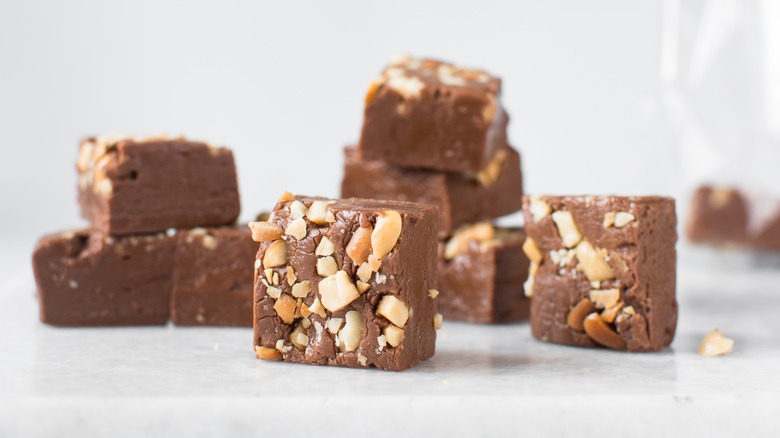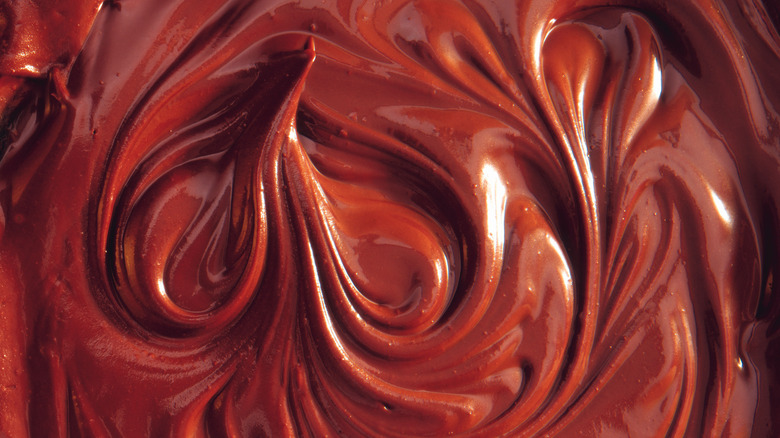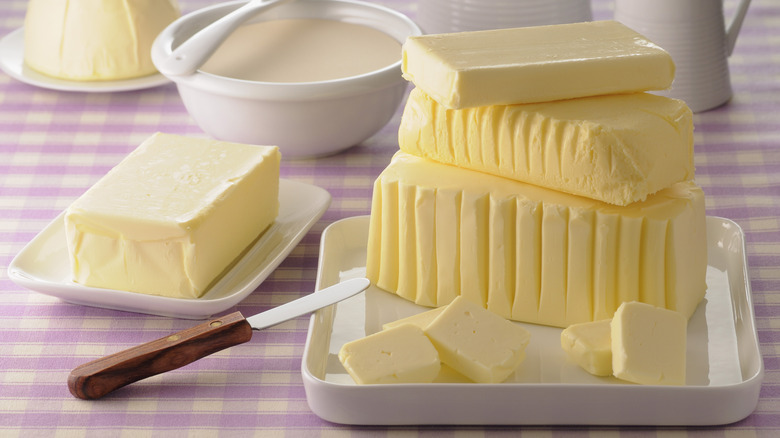How To Fix Homemade Fudge That Turned Out Far Too Oily
Few desserts can cause the same mouth-watering cravings as fudge. This succulent, sugary square has a flavor profile almost as rich as its history. In late 1800s Maryland, a confectioner botched a batch of caramel candies, consequently creating the first fudge. Although fudge calls for a shockingly small list of ingredients, there is no shortage of over-the-top fudge recipes to take this sweet treat to the next level.
Despite requiring very few ingredients, making fudge requires a fair bit of finesse. Making the perfect piece of fudge is by no means easy. One of the most common problems that arises making this delicious treat is when the fudge ends up overly oily. Fortunately, fixing the issue is fairly simple. Put the greasy mix back into a pot, add a few tablespoons of water, and stir the fudge on a low heat. Once this new mixture is complete, rebake the fudge. If you want to make this fix unnecessary, paying close attention to your fudge while it's being formed and using the right ingredients in the mixture can help prevent your fudge from becoming overly oily.
Fixing your oily fudge
A little liquid and a stint on the stove can remedy a number of fudge problems. Adding water and remixing is also how you can fix homemade fudge if it comes out grainy. This may slightly dilute the taste of your fudge, but a textural improvement will go a long way in covering for any flavor issues. You also need to make sure that you're stirring this second attempt enough, as a lack of mixing may have played a part in the first fudge's oily nature. However, oily fudge can also be caused by overmixing. You should only stir your mixture until it comes to a boil. Then, turn off the stove and allow the liquid fudge's sugar to fully dissolve. Once this dissolution has taken place, bring the mix back to a boil, but do not stir it.
When it comes to keeping your fudge from getting too oily, a modicum of prevention is worth a considerable amount of cure. A candy thermometer is an incredibly important tool for making fudge. It will allow you to keep a close eye on your fudge while it's still in its liquid phase and possibly prevent it from ever becoming oily in the first place. If you've passed the point where adding water to the mix is a possibility, you can also allow your fudge to cool, cut it up, and lay the squares out on paper towels to allow some of the oil to be absorbed.
The science of oily fudge
Butter, arguably the most important ingredient in fudge, is an emulsion, which is the fancy-sounding term for the end product that comes about when you force two things together that are resistant to being mixed. The incompatible ingredients in question are fat and water. The mix of ingredients that you're stirring together to make fudge is a similar emulsion, one that combines butter with milk and sugar. If your fudge is heated too much during the mixing process, or if the ingredients are insufficiently mixed together, the butter fat will separate itself from the liquids in the mix and rise to the top of the fudge, forming greasy pools. Being aware of the role that fat plays in fudge can be crucial to ensuring that your homemade fudge doesn't wind up too greasy.
Heat aside, other factors could have a hand in forming excessively oily fudge. Some potential problems include adding too much fat to your fudge mix, which often happens when a home cook chooses to use oil or butter interchangeably. Using low-quality chocolate — which is more likely to split in the heat — in your fudge will also cause it to get greasy. Fixing oily fudge is a relatively simple process, but sticking to quality ingredients and making sure you follow the recipe can make fixes unnecessary.


